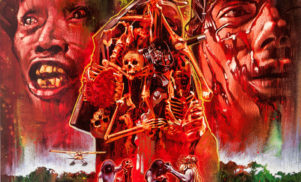Thanks to the graft of reissue labels and canny collectors, there’s an embarrassment of neglected, forgotten or misunderstood material being unearthed week by week.
The volume of new-old music doesn’t outpace new-new music, of course, but it’s not too far behind either. With so many more archival releases turning up on shelves, we’ve worked though the stacks to pick our favourite reissues and retrospectives of the last month.
Out this month (or thereabouts): frosted disco from the Factory vaults; a blood-spattered must-have for horror fans; first-rate Tanzanian plink-plonk; and, depending on who you ask, the album that gave psychedelia to the world.
10. Wolfgang Voigt
Protest – Versammlung 1
(Profan)
In 2010, Profan – the imprint run by German clubland veteran Wolfgang Voigt – sprouted a new arm, Protest. The sub-label has been a repository for regular releases from Voigt ever since, “heavily informed by his paradigm of sex, drugs and pop art.” Protest – Versammlung 1 pulls together highlights from the period, freshly remastered and supplemented by two unreleased tracks.
The paradiddling drum on the cover is telling: most of the tracks here offer brittle 4×4 with music hall flourishes and plenty of Felix Kubin kitsch. ‘Robert Schumann’ has some of Blawan’s knucklehead swing, albeit softened by jazzy licks, whereas ‘Endlich’ is redolent of Pantha Du Prince’s flinking 4×4. It’s undoubtedly one of Voigt’s slighter aliases, and some of the tracks here are little more than half-cocked sketches, but at its best, this garlanded Nutcracker techno has a highly distinctive sense of place and space.
9. Bunny Lion
Red
(Fantasy Memory)
February saw the release of a chunky 3xCD tribute to roots mystic Yabby You, but this month’s reggae curio of choice is Bunny Lion’s 1979 LP Red. Released on London’s Starlight Records and largely neglected at the the time, Red features instrumentals from man-about-town Linval Thompson, whose production and vocal work appeared on releases with Scientist, Barrington Levy and Eek-A-Mouse. ‘Bunny Lion’, meanwhile, is actually Puddy Roots, itinerant deejay and key member of Killamanjaro, one of the most formidable soundsystems of the early 1980s.
When Red’s good, it’s very good – beefy Thompson productions supplemented with full-throated toasting. ‘Rat Trap’ is a ten-ton bruiser, and ‘Girl Rockers’ is carried by guitar twangs that spiral into infinity. Fantasy Memory do right by Lion with a fine remaster, pressed onto red vinyl and supplemented with interesting biographical bumf. If you already have the original, you’re probably David Katz; if you don’t, it’s well worth a look.
8. Riz Ortolani
Cannibal Holocaust
(Death Waltz Recording Company / One Way Static)
Any regular pilgrims to this column will be familiar with horror specialists Death Waltz Recording Company and One Way Static; the former for a parade of stunningly rendered OSTs, from John Carpenter to Fabio Frizzi, the latter for an impressive, if smaller, collection of the same, with a particular line in repackaged Wes Craven scores.
This release marks their first collaborative effort – in reissue-land, something of an Avengers Assemble team-up. The LP in question? Riz Ortolani’s score for Rugerro Deodato’s bowel-boggling Cannibal Holocaust – a film so notorious that the director was charged with producing a snuff movie following reports actors had been murdered on set. Ortolani’s score is one of his best – a surprisingly chipper blend of chamber pop and brittle rhythm tracks, with a theme that, as esteemed colleagues have noted, could have been penned by Camera Obscura. This edition marks the record’s first ever outing on vinyl.
7. Van Kaye + Ignit
A Slight Delay
(Dark Entries)
Another month, another profusion of lo-fi 1980s bedroom ‘classics’ of varying esteem. Amidst the slurry, special mention goes to Reel To Reel, Staubgold’s collection of lost demo recordings by Liquid Liquid’s Dennis Young, and Mannequin’s reissue of 2+2=5’s glittering Into The Future – a slow-burner let down only by some stodgy vocals and occasional moments of listlessness.
Pick of the dark grapes, then, is this forgotten LP from Dutch duo Ed Van Kasteren (Van Kaye) and Ignatine Bekken (Ignit), originally self-released on c60 cassette back in 1981. Diversity is A Slight Delay’s strength, with the pair tilting from New Wave-inspired pop to abrasive mechanical mulch. In the first category: hiccuping calling card ‘Negroes in N.Y.’ and the rockabilly-inspired ‘Tonite’, which sounds like the Cramps duetting with Thomas Leer. In the second: the churning dysphoria of ‘Into Plan A’, and the prim, strangulated ‘Chapel’. Fans of X-Ray Pop, Gary Wilson and The Units will be in their element.
Dark Entries’ edition also bolts on their contemporaneous ‘Picassos on the Wall’ 7”, and marks the album’s first proper reissue outing,
6. Various
Music of Tanzania
(Sublime Frequencies)
Sublime Frequencies have had another strong month, putting out the well-received Folk Music Of The Sahel set, focusing on indigenous music from the Republic of Niger. Even better, though, is Music of Tanzania – a highly transportive set of recordings of Tanzania’s beleaguered Datoga, Hadza and Makonde communities.
Music of Tanzania collects field recordings made by ethnomusicologist Laurent Jeanneau at the turn of the millennium. Jeannau lives with his subjects for months at a time, and it shows in the intimacy and the vigour of these recordings – one feels entirely immersed in the rituals and ceremonies documented here, rather than pruriently snooping in from a distance. A lot of the music is bawdy and riotous: lengthy trance rituals, full-throated singsongs, a boozy recording of a Makonde preteen sexual initiation. More temperate are gorgeous solo recordings of a fingerpicked malimba and the zeze fiddle. It’s probably my favourite field recording release since ΚΕΜΑΛ’s gorgeous Music of the Fire Walkers; more volumes are promised.
5. B.C. Gilbert / G. Lewis
3R4
(Superior Viaduct)
Following the dissolution of Wire’s first incarnation in 1980, the band’s Bruce Gilbert and Graham Lewis moved with speed and fury. By the time the year was out, the duo had put out two head-spinning albums as Dome (memorably collected in 2011 by Editions Mego), a 12” of harrowed exotica as Cupol, and 3R4 – their only album credited to the comparatively formal B.C. Gilbert / G. Lewis moniker.
Palette cleansing interludes aside, 3R4 is made up of two extended pieces. ‘3.4…’ has a heavy nautical bent: an ostinato churns back and forth with tidal force, and wispy guitar tones witter like gulls. ‘R’ is even better – doomy lo-fi clatter, which deliquesces into humming, forbidding drone work. It’s an album that takes a few listens to creep up on you; not many other records this month have gone about their business quite so insidiously.
Bonus factoid: 3R4 holds the honour of being the second album ever released on 4AD (The first? Bauhaus’ goth manual In The Flat Field).
4. Alan Watts
This Is IT
(Numero Group)
In the early 1960s, before psychedelia piqued the interests of mop-tops and hangers-on, small pockets of academics and curious amateurs were investigating Eastern mysticism and the effects of psychedelics. Alongside your Huxleys and your Beat thinkers was Alan Watts, an Englishman based on the West Coast responsible for key psychedelic treatise The Joyous Cosmology. The same year saw the release of This Is IT, a collection of jams and dialogues that has built a reputation in some quarters as the first ever psychedelic record, despite being a fearsome bugger to track down prior to a CD reissue in 2004.
This Is IT is emphatically not for everyone: it’s rambling, navel-gazing and muddled, and gives every impression of having been recorded on LSD. But anyone tuned into freak sounds will find plenty to enjoy in these “controlled accidents”: ‘Love You’ is a stunning piece of glossolalia that prefigures Steve Reich phase experiments, and ‘Onion Chant’ careers violently into the depths of madness. It’s crustier than an artisanal loaf, but This Is IT’s music is hypnotic enough to justify its reputation; fans of Shadow Ring and early Hype Williams are advised to enquire.
3. Bal Paré
Early Recordings
(Medical)
Confession: I goofily, unreservedly, love Bal Paré – ‘Palais D’Amour’ (featured on Angular’s excellent 2010 Cold Waves and Minimal Electronics) ranks up there with my favourite ever songs. The German outfit released two LPs in the early 1980s, earned a sizeable following in Sweden, and burned out in the middle of the decade. In contrast with a lot of excavated coldwave relics, their music fizzes with life and verve. No music for mausolea here – Kraftwerk and Depeche Mode c. Speak and Spell are the main points of reference.
This recent collection from Medical pulls together (mostly) lesser-known material from their heyday, most of which was previously only available on a mid-90s CD compilation on Tatra. ‘Palais D’Amour’ stands out a mile of course, but a few tracks here tug on similar synapses – the chipper ‘Die Hunde Sind Los!’, complete with goofy calliope interlude; muscular gloomfest ‘Nocturne’; and ‘Metamorphose’, which boasts a gorgeous coda. The band’s Matthias Schuster handles the reissue, which marks this music’s first ever outing on vinyl.
2. Trevor Wishart
Red Bird: A Political Prisoner’s Dream
(Sub Rosa)
Trevor Wishart is an electroacoustic music pioneer – and if you’re the sort of reader who sees those three words and instantly turns to flee, it’s important to stress that Red Bird is one of the most arresting records of any stripe or vintage you’ll hear all month. Often based around twisted, mangled human voices, Wishart’s work stretches back five decades – and as routes in go, you could certainly do worse than this stunner, now back on vinyl for the first time in almost half a century.
Composed over five years and released in 1978, Red Bird collects a menagerie of sounds – avian chirrups, gargled nonsense, fiddled tape loops, and birdsong manipulated to sound like clanking machinery. Sounds are muddled and merged, and screams – orgasmic or otherwise – continually cut through the mix. It’s a harrowing, abrasive listen, playing like a calisthenics session in the seventh circle of hell: noise enthusiasts will find plenty to enjoy, and you can hear the seeds of ideas that would be developed by the likes of Gregory Whitehead or Maja Ratkje. Torture, erotics, misery – it’s all here.
1. Martin Hannett & Steve Hopkins
The Invisible Girls
(Factory Benelux)
Most readers will be more than familiar with Factory’s in-house producer Martin Hannett, whose distinctive style – think Black Ark dub coated in rime – gave Joy Division a career and ESG, Magazine and OMD a boot up the fundament. Fewer, though, will be as well versed in Hannett’s own output as a musician, much of it produced alongside Manchester session man Stephen Hopkins. From 1976 until the late 1980s, the two served as the nucleus of The Invisible Girls, a shapeshifting production unit whose collaborators included Nico, Penetration’s Pauline Murray and John Cooper Clarke.
Following a low-key 2014 reissue of the band’s superb 1980 LP with Murray, Factory Benelux have pulled together this carefully curated odds’n’sods collection. The Invisible Girls encompasses over a decade’s worth of work, much of it unreleased or off-radar: indeed, the pinnacle of the collection is a series of five previously unreleased tracks (described as ‘Moods’) of disco-inspired glimmer. ’Scandinavian Wastes’ offers six minutes of Lynchian swoon; ‘Hudderfield Wastes’ plays like a wild Saturday night in the iglootèque. Also bundled is the pair’s first collaboration (a beautiful, moth-eaten soundtrack for animated film All Sorts of Heroes), assorted Hannett drone sketches, surly collaborations with Nico and Section 25, and a gorgeous bit of proto-ambient techno called ‘Space Music’. There’s a lot of strange, sometimes contradictory music here, but Hannett’s unique vision peeks through. Essential.
































